Challenge coin
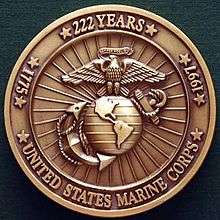
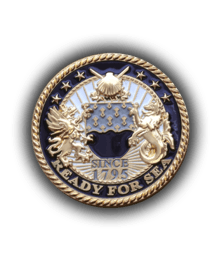
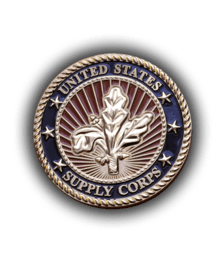
A challenge coin is a small coin or medallion (usually military), bearing an organization’s insignia or emblem and carried by the organization’s members. Traditionally, they are given to prove membership when challenged and to enhance morale. In addition, they are also collected by service members. In practice, challenge coins are normally presented by unit commanders in recognition of special achievement by a member of the unit. They are also exchanged in recognition of visits to an organization.[1]
Origins
There are several stories detailing the origins of the challenge coin.
The Roman Empire rewarded soldiers by presenting them with coins to recognize their achievements.[2]
According to the most common story, challenge coins originated during World War I.[3][4] Before the entry of the United States into the war in 1917 American volunteers from all parts of the country filled the newly formed flying squadrons. Some were wealthy scions attending colleges such as Yale and Harvard who quit in mid-term to join the war.[5][6]
In one squadron, a wealthy lieutenant ordered medallions struck in solid bronze and presented them to his unit. One young pilot placed the medallion in a small leather pouch that he wore about his neck. Shortly after acquiring the medallion, the pilot's aircraft was severely damaged by ground fire. He was forced to land behind enemy lines and was immediately captured by a German patrol.[7] In order to discourage his escape, the Germans took all of his personal identification except for the small leather pouch around his neck. In the meantime, he was taken to a small French town near the front. Taking advantage of a bombardment that night, he escaped. However, he was without personal identification. He succeeded in avoiding German patrols by donning civilian attire and reached the front lines. With great difficulty, he crossed no-man's land. Eventually, he stumbled onto a French outpost. Saboteurs had plagued the French in the sector. They sometimes masqueraded as civilians and wore civilian clothes. Not recognizing the young pilot's American accent, the French thought him to be a saboteur and made ready to execute him. He had no identification to prove his allegiance, but he did have his leather pouch containing the medallion. He showed the medallion to his would-be executioners and one of his French captors recognized the squadron insignia on the medallion. They delayed his execution long enough for him to confirm his identity. Instead of shooting him they gave him a bottle of wine.[2][5][6][8]
Back at his squadron, it became tradition to ensure that all members carried their medallion or coin at all times.[2] This was accomplished through challenge in the following manner: a challenger would ask to see the medallion, if the challenged could not produce a medallion, they were required to buy a drink of choice for the member who challenged them. If the challenged member produced a medallion, then the challenging member was required to pay for the drink. This tradition continued throughout the war and for many years after the war while surviving members of the squadron were still alive.[6][8]
According to another story, challenge coins date back to World War II and were first used by Office of Strategic Service personnel who were deployed in Nazi held France. Similarly, Jim Harrington proposed a Jolly sixpence club amongst the junior officers of the 107th Infantry.[2] The coins were simply a local coin used as a "bona fides" during a personal meeting to help verify a person's identity. There would be specific aspects such as type of coin, date of the coin, etc. that were examined by each party. This helped prevent infiltration into the meeting by a spy who would have to have advance knowledge of the meeting time and place as well as what coin was to be presented, amongst other signals, as bona fides.
While a number of legends place the advent of challenge coins in the post-Korean Conflict era (some as late as the Vietnam War), or even later, Colonel William "Buffalo Bill" Quinn had coins made for those who served in his 17th Infantry Regiment during 1950 and 1951.
Colonel Verne Green, commander of the 10th Special Forces Group-A, embraced the idea. He had a special coin struck with the unit's crest and motto in 1969. Until the 1980s, his unit was the only unit with an active challenge coin tradition.[9][10][11]
There is another story about an American soldier scheduled to rendezvous with Philippine guerrillas during WWII. As the story goes, he carried a Philippine solid silver coin that was stamped on one side with the unit insignia. The coin was used to verify, to the guerrillas, that the soldier was their valid contact for the mission against the Japanese.
The challenge coin tradition has spread to other military units, in all branches of service, and even to non-military organizations as well as the United States Congress, which produces challenge coins for members of Congress to give to constituents. Today, challenge coins are given to members upon joining an organization, as an award to improve morale, and sold to commemorate special occasions or as fundraisers. In the Air Force, military training instructors award an airman's coin to new enlisted personnel upon completion of their United States Air Force Basic Military Training and to new officers upon completion of the Air Force Officer Training School.[8][12]
In 2008, Leatherneck Magazine gave a 90th anniversary Leatherneck challenge coin to a select few readers who sent in letters to their "Sound Off" section which the editors particularly liked.[13]
U.S. presidents
President Bill Clinton displayed several racks of challenge coins, which had been given to him by U.S. servicemembers, on the credenza behind his Oval Office desk. These coins are currently on display at the Clinton Library. The challenge coins appear in the background of his official portrait, now hanging in the White House.
President George W. Bush received a challenge coin from a Marine combat patrol unit during his short but unexpected visit to Al-Asad Airbase in Anbar province, Iraq, 3 September 2007.[14]
President Barack Obama placed challenge coins on the memorials of the soldiers killed in the 2009 Fort Hood shooting.[15]
Challenging
The tradition of a challenge is the most common way to ensure that members are carrying their unit's coin. The rules of a challenge are not always formalized for a unit, and may vary between organizations. The challenge only applies to those members that have been given a coin formally by their unit. This may lead to some controversy when challenges are initiated between members of different organizations and is not recommended. The tradition of the coin challenge is meant to be a source of morale in a unit, and forcing the challenge can cause a reverse effect. The act of challenging is called a "Coin Check" and is usually loudly announced.[8][10][16]
The challenge, which can be made at any time, begins with the challenger drawing his/her coin, and slapping or placing the coin on the table or bar. In noisy environments, continuously rapping the challenge coin on a surface may initiate the challenge. (Accidentally dropping a challenge coin is considered to be a deliberate challenge to all present.) Everyone being challenged must immediately produce the coin for their organization and anyone failing to do so must buy a round of drinks for the challenger and everyone else who has their challenge coin. However, should everyone challenged be able to produce their coin, the challenger must buy a round of drinks for the group.[8][9][10]
While most holders of challenge coins usually carry them in their pockets or in some other readily accessible place on their persons, most versions of the rules permit a challenged person "a step and a reach" or if an individual has an extra coin to pass it off to the person closest to him or her. Coins on belt buckles or key chains are not acceptable for meeting a challenge. However, a coin worn around the neck is acceptable for meeting a coin challenge.[9][10][16]
Variants of the rules include the following but not limited to. If someone is able to steal a challenge coin, everyone in the group must buy a drink for that person. During a challenge, everyone in the group must buy a drink for the holder of the highest-ranking coin. A coin presented to a low rank, by a high rank, (i.e.: Admiral) trumps all low rank coins in a challenge. Traditionally, the presentation of a coin is passed during a handshake. Some units provide strict time limits to respond to a challenge.
Traditionally, rules of a challenge include a prohibition against defacing the coin, especially if it makes it easier to carry at all times. If the challenge coin is attached to a belt buckle or key ring, or has had a hole drilled in it to attach to a lanyard, it no longer qualifies as a challenge coin.[10][17] A safer place to carry a coin is in a pouch worn around the neck.
Coin appearance
There are many finishes available—from a simple pewter to 24K gold. While there are only a few base metals, the patina (finish) can range from gold, silver, nickel, brass, copper. bronze plus the antiqued variations. Soft or hard enamel or a printed inset with an epoxy coating may add color (the epoxies are often more resilient and scratch resistant than the metal surfaces).[18]
Cost
Challenge coins are moderately inexpensive to design and produce. There are two basic processes by which to manufacture: zinc-alloy castings or die struck bronze.
Zinc alloy castings offer the advantage of low cost. While a die struck bronze or brass coin is more expensive, the result renders a far superior product (numismatic quality).
As of 2010, coins manufactured in China and South Korea typically cost between US$2.50 to US$7.00 per coin depending on production process and complexity of design, laser engraving, enamels, voids, etc. The dies must be sculpted by an artist and can range in cost from US$50 to US$300 depending on complexity. The cost of domestic manufacture can be many times this amount.
In order to be competitive, most North American companies offering challenge coins rely on having the product manufactured 'off-shore'. Many challenge coins are fabricated in South Korea, as the connection to the US military bases there is strong, and costs are cheaper than those made in the US.
Uses
Besides using coins for challenging, they are also used as rewards or awards for outstanding service or performance of duty. As such, they are used as a tool to build morale.[8][16] Military officials occasionally give them to non-military personnel for outstanding service or rewards, like the case of student athletes at Northeastern University[19]
In the context as they are used by the modern U.S. military, the tradition probably began among special forces units during the Vietnam War. The tradition spread through the Airborne community, and by the early 1980s also into the 75th Ranger Regiment. As officers were reassigned as their careers progressed, they carried with them the tradition of awarding a unit coin for acts that were worthy of recognition, but yet lacked enough merit to submit the soldiers act for an official medal.
One widely known challenge coin in the United States Air Force was the "Bull Dog" challenge coin that was exclusive to B-52 enlisted tail gunners. Since the B-52 gunner position was phased out in 1991, this famous challenge coin has become rarer.
This coin was presented to gunners upon graduation from their Air Force technical training and their entry into the "Gunners Association". In the earlier days of bombers, a bean or a nugget was used. The coin represents the attributes of strength and courage as reflected in the Bulldog, the gunner's official mascot. The coin was also given to certain "honorary gunners", usually commanders and leaders who portrayed the spirit of the bulldog.
Some collectors buy them for their numismatic value.
Coins given as awards for accomplishments are normally given to the recipient during a handshake, passing from the right hand of the giver to the right hand of the awardee. It is also normal for the giver to offer a brief explanation of the reason for awarding the coin.
"Perhaps the largest collection of Army Engineer related coins exists in a large cabinet in the Army Engineer Association's (AEA) Engineer Regimental Store, located in the Engineer Museum at the home of the Engineer Regiment. These coins were donated by store customers who have passed through the store since it opened in the late 1980s."[20]
Popular culture
- Jessica Simpson and her fellow basic training graduates get coined in Private Valentine: Blonde & Dangerous.
- In the prologue of James Rollins' novel Amazonia, an American ex-Special Forces CIA operative who had gone missing four years earlier, in South America, is identified by his challenge coin.
- In the "Betrayed" episode of the adventure drama television show Chase, Deputy US Marshal Annie Frost, is shown to carry around her challenge coin regularly. A recent addition to the Marshal team, Luke, later expresses his frustration at not earning his challenge coin yet- however he earns it at the end of this episode.
- In "Foundation", episode 18 of Criminal Minds Season 7, (aired on 21 March 2012), Special Agent Derek Morgan uses a challenge coin, first flipping it through his fingers then by rolling it on the floor, to establish communication with a traumatized boy who is mute and withdrawn after escaping his kidnapper. To give the boy hope, Morgan also tells him the version of the origin story of challenge coins with the downed WWI pilot crawling through no mans land only to be captured by the French then rescued by his challenge coin being recognized. Morgan lets the boy keep the coin, and in a closing scene, Morgan is shown picking up another coin to carry with him from a collection of 13 more coins displayed prominently on his desk.
- Colonel Eli McNulty coins Samantha Liston in E-Ring when she is in the running to be assistant secretary of defense for special operations and a general is trying to put a stop to it. At one point the general initiates the 'coin check' to show that she should not have a senior job as she has not seen combat and, of course, Liston has no challenge coin—thus proving his point.
- At the end of the long-running American adventure drama television show JAG, the two main characters decide to marry, then flip the challenge coin of retired Rear Admiral A. J. Chegwidden to decide who will resign his or her military commission to accompany the other to a new duty station. The final image freezes with the coin in the air; the audience never sees it fall.[16]
- In the NCIS episode "Cloak" (18 November 2008), the United States Secretary of the Navy gives Tony his coin, apparently as a means of identification. Tony relates to Ziva David the meaning of challenge coins, explaining that they are a form of bragging rights for who has "rubbed elbows" with the biggest brass. He also states that they will never have to buy drinks again.
Outside of the military
Challenge coins are also exchanged outside the military. NASCAR,[21] the NFL, cadets of the Civil Air Patrol,[22] Eagle Scouts and World Series of Poker all have their own challenge coins.[23] They are also becoming popular with police departments, fire departments and fraternal organizations. In 2007, the Utah Symphony and Opera gave challenge coins to all of its staff and musicians, making it the first symphony organization in America to do so. Franklin Public School in Ontario has a coin that is given to graduates, featuring its mascot 'Frankie'.[24] Many non-profits, especially those with connections to the military, give challenge coins to donors to acknowledge their support of the organization.[25][26]
National Association of Buffalo Soldiers and Troopers Motorcycle Club
Another organization in which challenge coins have gained popularity is the "National Association of Buffalo Soldiers and Troopers Motorcycle Club" (NABSTMC), which has over 85 chapters totaling over 2,000 members. The coin is 1.75 inches (44 mm) in diameter, minted in solid brass with an antique finish. The front of the coin bears the NABSTMC logo. Also depicted is the year the club was established, which was 1999. The back of the coin proudly displays the "cavalry charge" with the motto of the 9th and 10th cavalry buffalo soldiers: "we can, we will" and "ready forward". The coin must be earned by the members and can only be presented by a national officer or chapter president for a noteworthy accomplishment.[23]
Harley Owners Group
In 2009, the Harley Owners Group (HOG) created and made available its own challenge coin to Harley-Davidson motorcycle owners through the HOG members only website, stating: "Those who ride Harley-Davidson motorcycles share a bond in much the same way as those who have served their country with pride. Carrying a H.O.G. National Challenge Coin in your pocket, on your bike or off, is a meaningful way to show your pride of Harley-Davidson ownership—while also paying tribute to those who serve." The HOG National Challenge coin, measures 1.75 inches (44 mm) in diameter and is minted in US from solid brass alloy with an antique finish. The HOG eagle logo is stamped on the coin. The Harley-Davidson bar and shield logo encircled with the words "the official riding club of Harley-Davidson" is stamped on the back.[27]
Media
In his audio commentary for the DVD release of Iron Man 2, film director Jon Favreau notes that he had Iron Man 2 challenge coins made to distribute to United States Air Force personnel as a gesture of thanks for their cooperation while the production (and its predecessor, Iron Man) filmed on location at Edwards Air Force Base.[28]
Bill Prady, executive producer of The Big Bang Theory, recently gave the Big Bang Theory "executive producer's challenge coin" to the crew of the last space shuttle.[29]
On the "Rockets" episode of Lock N' Load with R. Lee Ermey, R. Lee (Gunny) Ermey presents a challenge coin to 2nd Lt. Carr as a reward for being the "top gun" in his class with the Javelin Portable Rocket Launching System.[23]
Members of the American Radio Relay League who are volunteer examiners may carry the VEC (volunteer examiner coordinator) challenge coin. These members are responsible for administering Federal Communications Commission sanctioned examinations that allow successful applicants to qualify as amateur radio operators in the three different license categories of: technician, general, and amateur extra.[30]
The crew of Breaking Bad were given challenge coins designed by show creator Vince Gilligan for each new season. Another challenge coin was also included in the Blu-ray set of the entire series of the show.[31]
Video game companies like Treyarch gave these coins with certain packages for the release of Black Ops 2.[32]
The crowdfunded movie Lazer Team gave challenge coins to its backers as an optional perk of funding the movie.[33]
Canada
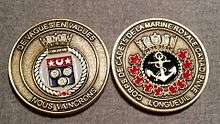
One of the first appearance of a challenge coin within the Canadian Forces was that of the Canadian Airborne Regiment. Although conceptualized in the early 1970s, it was not officially adopted until the regiment returned from Cyprus in 1974.[34]
Recognized as an "Americanism", the widespread use of challenge coins is new to the Canadian Forces (CF) and was introduced by General Rick Hillier as the Canadian Army began to work closer with the US military. While many regiments and military establishments purchase them as 'challenge coins', most branches and schools within the CF use them for presentation purposes.
The first RCAF coin belonged to 427 Squadron. Back in the Second World War, 427 and the film studios Metro-Goldwyn-Mayer (MGM) shared the lion as their respective symbol. During a ceremony held on 27 May 1943, a bronze statuette of a Lion was presented to the Squadron as were MGM's coins for the Squadron members.[35] These coins granted free access to the MGM's theaters in Britain and were popular with aircrew and ground crew alike. In 1982, the custom was reintroduced by Lieutenant-Colonel Hugh Cunnigham, then the squadron commanding officer; it has since expanded widely within the RCAF Tactical Aviation community.
Every new officer cadet at the Royal Military College of Canada in Kingston, Ontario, is issued a challenge coin upon completion of First-Year Orientation Period. The coin is engraved with the name of the college in French and English surrounding the college's coat of arms on the obverse. The cadet's college number and the Memorial Arch is on the reverse surrounded by the motto in both languages.
Members of the Corps of Royal Canadian Electrical and Mechanical Engineers Fund are issued challenge coins with the current RCEME badge and the member's branch fund membership number on the obverse side, and the original pre-unification RCEME badge and branch motto on the reverse side. Usually, these are issued to craftsmen at the Canadian Forces School of Electrical and Mechanical Engineering, in Borden, Ontario, where branch fund membership is first offered.
Many of the CF training centres and staff colleges have a unique coin—some available for the students to purchase, others available only by presentation by the establishment or the commandant for exemplary achievement while attending the facility. General Walter Natynczyk, when he was chief of the Defence Staff, and the Canadian Forces chief warrant officer often present their personalized coins to deserving soldiers.
Police, security and fire departments have embraced the concept and have found coins to be an excellent means of team building and creating a sense of brotherhood or belonging. Many feature a patron saint, badge or representative equipment.
Switzerland
The challenge coin tradition was introduced into the Swiss Armed Forces by American officers on training missions and other assignments for the Organization for Security and Co-operation in Europe, of which Switzerland is a member. Coins are not issued, but rather ordered and paid for by Swiss officers of various branches within the Army.
Australia
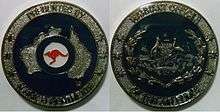
Coins have come into use by various Australian political leaders, senior officers and NCOs, under the influence of presentations from American personnel.[11]
Britain
British military medical units discovered the tradition while working with American units in Iraq and Afghanistan. The Department of Military Anesthesia and Critical Care has been issuing a coin since 2006.[4]
See also
References
- ↑ "Challenge Coin". GlobalSecurity.org. Retrieved 10 March 2008.
Commanders use specially minted military coins to improve morale, foster unit esprit de corps and honor service members for their hard work. ... In one squadron, a wealthy lieutenant ordered medallions struck in solid bronze and presented them to his unit.
- 1 2 3 4 Myers, William J. (April 2007). "Meet the Challenge". The Numismatist: 63.
- ↑ Carter, Chris (November 2013). "BACCN Military Region Challenge Coin". Nursing in Critical Care. British Association of Critical Care Nurses. 18 (6): 321. doi:10.1111/nicc.12058_8.
- 1 2 Mahoney, PF (2010). "The DMACC Coins". Journal of the Royal Army Medical Corps. 156: S412. doi:10.1136/jramc-156-04s-25.
- 1 2 Pike, John (4 March 2005). "History of the Challenge Coin". Globalsecurity.org. Retrieved 13 August 2014.
- 1 2 3 Knowlen, Charles (May 2011). "History of the Challenge Coin" (PDF). Bangor International Airport. Retrieved December 15, 2014.
- ↑ "History of Custom Challenge Coins". Embleholics. Retrieved 5 May 2015.
- 1 2 3 4 5 6 Snyder, Jonathan (5 March 2007). "Challenge Coins a Trademark Tradition for American Military". Pacific Air Force, United States Air Force. Archived from the original on 12 December 2008. Retrieved 13 May 2007.
- 1 2 3 Myers, William J. (April 2007). "Meet the Challenge". The Numismatist: 64.
- 1 2 3 4 5 "Special Forces Coin Rules and History". Sfalx.com. Retrieved 13 August 2014.
- 1 2 Christian, Davenport (n.d.). "Power Players Flip for 'Challenge Coins'". Regional Business News. The Washington Post – via EBSCOhost.
- ↑ 737th Training Group. "Basic Military Training" (PDF). Lackland Air Force Base. p. 3. Retrieved December 15, 2014.
- ↑ Keane, R.R. (1 January 2008). "Reply to William F. Storm's letter to Sound Off". Leatherneck. 91: 2.
- ↑ http://news.yahoo.com/photo/070903/481/4ebf5940e5794708b84ac658533001b4. Retrieved 4 September 2007. Missing or empty
|title=(help) - ↑ "President Obama Addresses Fort Hood Memorial". ABC News. 10 November 2009. Retrieved 3 June 2013.
- 1 2 3 4 Michelsen, Michael W., Jr. "A Passionate Collector: Collector: Adam Mulholland, Passion: Challenge Coins". Antiques & Collecting: 60, 64.
- ↑ "History of the Military Challenge Coin". U.S. Air Force Wire Dawgs. Archived from the original on 11 November 2007.
- ↑ Myers, William J. (April 2007). "Meet the Challenge". The Numismatist: 64–65.
- ↑ "Honoring Leadership". Northeastern Voice. Northeastern University. 20 (8): 3. February 29, 2008.
- ↑ Morgan, Michael (September–October 2011). "Veterans & Reunions". Army Engineer Magazine: 30.
- ↑ Medford, Jesse L. "Challenge Coins… Not Just for the Military". Challenge Coin Association. Archived from the original on 19 June 2012.
- ↑ "Chapter 4: The Cadet NCO & The Team" (PDF). Learn to Lead. vol. 2. Civil Air Patrol. p. 20.
- 1 2 3 "Challenge Coin: Challenge Coins Outside of The Military". Challenge Coins Military. Archived from the original on 13 August 2014. Retrieved 13 August 2014.
- ↑ Cummings, Melanie (8 July 2008). "People in Coins". Canadian Coin News. p. 15.
- ↑ r4esh (25 April 2013). "Challenge Coins for Non-Profit Fundraising". D&R Military Specialties. Retrieved 13 August 2014.
- ↑ "Non-Profit Challenge Coins". Challenge Coins Plus. 13 March 2012. Retrieved 13 August 2014.
- ↑ "Harley Owners Group Official Challenge Coins". Ultimate MotorCycling Magazine. 1 December 2009. Retrieved 13 August 2014.
- ↑ "Collider Goes to the Set of IRON MAN 2 - Read a Preview - Plus Pictures of the IM2 Challenge Coin". Collider.com. Retrieved March 13, 2015.
- ↑ "STS-135 Crew's Visit to 'The Big Bang Theory'". collectSPACE: Messages. Retrieved 3 June 2013.
- ↑ "Pins, Patches, & Supplies: Volunteer Examiner Challenge Coin". ARRL. Retrieved 13 August 2014.
- ↑ "The 'Breaking Bad' Complete Series Set Looks Awesome". The Huffington Pos. 9 September 2013. Retrieved 13 August 2014.
- ↑ MacManus, Christopher (29 August 2012). "Treyarch Teases 'Call of Duty: Black Ops 2' Collector's Editions". CNET. Retrieved 13 August 2014.
- ↑ "Lazer Team by Rooster Teeth". Indiegogo. Rooster Teeth. Retrieved 27 January 2016.
- ↑ Mongeon, Denis. "A Challenging Collection" (PDF). Retrieved 31 August 2012.
- ↑ "Original MGM Lion Coin". 427 Squadron Association.
Further reading
- Acosta, Wil (4 March 2005). "History of the Challenge Coin". Marine Corps News. 20053485017. Retrieved 30 December 2006.
- "Challenge Coin". GlobalSecurity.org. Retrieved 30 December 2006.
- Thompson, Scott (30 March 2007). "Of Military Excellence, Affiliation and Heraldry: The Story of Military Coins". The Fort Leavenworth Lamp. Archived from the original on 16 December 2014. Retrieved 3 April 2007.
- Marotta, Michael E. (December 2007). "Take the Challenge" (PDF). The Numismatist.
- Cummings, Melanie (8 July 2008). "Challenge Coins Are Like Hotcakes at Public School" (PDF). Canadian Coin News.
- Brooks, Jeanne Fraser (August 1994). "Coining a Tradition". Soldier's Magazine. 49 (8).
- Michelsen, Jr., Michael W. "A Passionate Collector: Collector: Adam Mullholland: Passion: Challenge Coins". Antiques & Collecting: 60 & 64.
- Schwartz, Richard R. (18 October 2011). "Soft or Hard Enamel Coins: Which is Better?". challengecoinsltd.com. Retrieved 31 October 2011.
- Michael, Thomas; Čuhaj, George S. (2006). Coins & Currency of the Middle East. KP. pp. 168–179. ISBN 9781440225208. OCLC 767500328.
External links
| Wikimedia Commons has media related to Challenge coins. |
